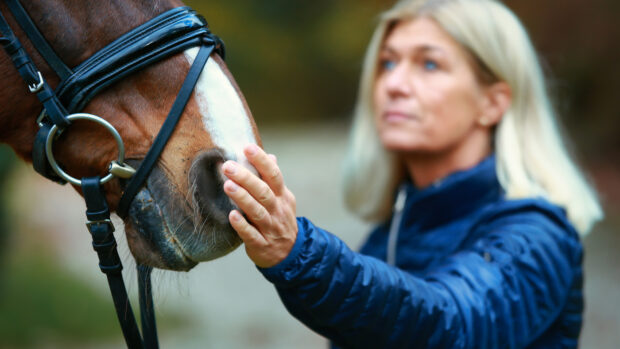Promotional Feature with NAF
By Kate Hore, RNutr (Animal)
Just as much of the Western world is seeing an obesity epidemic in people, and their pets, so equine obesity is also one of the biggest challenges to our horse’s health, here and across Europe. Studies show the incidence of overweight and obese equines can be as much as half of the population2. The issue is not just limited to horses in light or no work, as research in Swedish Riding Schools found that even when horses are in regular work, 25-32% of those assessed for general health were found to be overweight3. All horses and ponies are at risk, so it’s important to act early, but how can owners be aware of the signs and put in suitable management to control weight gain?
Firstly, monitor your horse’s weight regularly, as when you see your horse daily it can be difficult to spot gradual changes. A weighbridge gives an accurate measurement, but few of us have easy access to one. Therefore, a weigh tape is a good alternative; they don’t always give a strictly accurate measurement, but if the same person uses the same tape weekly it will show up any changes. Also, try body condition scoring your horse. There are two accepted systems, the 1-9, where 1 = very poor and 9 = obese, developed by Henneke et al, and 0-5, where 0=very poor and 5=obese, developed by Carroll and Huntington4,5. It doesn’t really matter which you choose, so long as you always state which one you’re using. We advise the 0-5 system, as it’s simple to visualise and more commonly used across Europe.
Look too for fat pads, which are areas where excess fat are deposited. In horses those are typically along the crest of the neck, at the shoulder, over the ribs and at the tailhead. In particular, assess the neck. With the exception of stallions, no horse should have a cresty neck, and recent research shows that a crest, particularly when present without excess weight elsewhere on the horse, can be an indicator of insulin dysregulation, such as seen in Equine Metabolic Syndrome (EMS)6.

Typical areas for fat pads to accumulate on an overweight horse

A pony with a cresty neck
Adopting suitable management regimes can help with maintaining a healthy weight in horses prone to weight gain. Dependent on grazing management, the horse’s turnout will either provide all, or a significant amount, of the horse’s daily energy intake. Therefore managing grazing is key to controlling weight gain. Simply reducing the amount of time at grass is not the best approach, partly as it means longer time spent stabled, which is not ideal for many reasons, and partly because it’s unlikely to actually work. Research shows horses, particularly ponies, can learn to increase their bite rate in response to reduced grazing time, such that actual intake is little reduced even if they can only graze for a few hours7. Essentially, they pile their plate high when they get the chance! However, use of a grazing muzzle does significantly decrease intake, while allowing them to stay out at pasture and trickle graze, so is a more preferable option for most. Alternatively, if possible, look at using ‘paddock paradise’, where a track with limited grazing is available around the edge of the field, leaving the centre for forage production or riding. Good track systems suit all horses in the herd, as they encourage horses to keep moving around naturally, so are worth the investment required to set them up, where they are possible.

An example of a track system designed to limit grazing and encourage horses to move while turned out.
For all types of horses and ponies it’s important that forage and fibre remain the predominant part of the diet, and either fed ad-lib, or as close to that as possible. Of course, this is a challenge for owners of horses prone to weight gain. Therefore, especially when they are stabled, we need to consider the both source of forage, and how to provide it.
Hay-nets, particularly those with small holes, can be useful for extending feed time, keeping the horse trickle eating as nature intended, so are ideal for some8. However hay-nets don’t replicate the natural feeding position and, particularly small hole nets, can increase both signs of frustration and physical strain on the neck in some horses; so for these animals consider floor-based slow-feeders as an alternative9,10. When choosing forages ideally choose a low NSC (non-structural carbohydrates) hay, of around 10-12% NSC, or if this isn’t possible, soak hay to reduce sugar levels.
Targeted nutrition can also be useful. The use of oral magnesium is known to support insulin sensitivity, such as diabetes, in people, and this relationship is now becoming established in horses11, where on a practical level differences in the mid-neck circumference when supplementing with magnesium are observed. Similarly, key herbal support can also be supportive. Marine extracts are particularly interesting, with both brown algae and spirulina showing promise for weight loss and insulin support, with spirulina showing evidence in equines12, 13. However it’s not all about seaweed, with natural compounds like curcumin, found in turmeric, and leucine, found in sunflower, also showing evidence for metabolism support14,15. Of course, targeted nutrition alone is not the answer, but is recommended as part of good management and a suitably designed diet for horses prone to weight gain.
An undergraduate placebo controlled trial of a magnesium and herbal-based supplement for horses, found overweight horses lost more weight and more quickly than those on the placebo, with an observable change and average weight loss of 24.2kg over nine weeks16.
In conclusion, for those managing horses prone to weight gain the spring and summer grass growth can be a particular challenge. However working together with a suitable management regime, and an energy controlled diet, NAF Slim Pellets can be recommended to provide essential phytonutrients to the diet, and to support a healthy weight in horses prone to weight gain.
Supergroom Alan Davies says: “Slim is a fantastic product which can be a real help in watching your horse’s waist line. I have been so pleased with the results we have had with Slim and would definitely recommend it to anyone whose horse needs help with weight control.”
Selected references:
- Association for Nutrition. http://www.associationfornutrition.org/default.aspx?tabid=71
- Hesta M, Roelfsema E & Van Doorn D (2017) Safe Weight Watchers for Equines: European Equine Health & Nutrition Congress. 8th EEHNC, Antwerp, 2017.
- Yngvesson J et al (2019) Health and Body Conditions of Riding School Horses housed in groups or kept in conventional tie-stall/box housing. Animals (Basel). Mar 9(3), p73
- Henneke et al (1988) Relationship between condition score, physical measurements and body fat percentage in mares. Equine Veterinary Journal. Oct 15(4) p371-2
- Carroll C.L & Huntington P.J (1988) Body condition scoring and weight estimation of horses. Equine Veterinary Journal. 20(1) p41-5
- Fitzgerald D.M et al (2019) The cresty neck score is an independent predictor of insulin dysregulation in ponies. PLOS ONE 14(7) e0220203
- Longland A.C, Ince J & Harris P.A. (2011) Estimation of pasture intake by ponies from liveweight change during six weeks at pasture. Journal of Equine Veterinary Science. 31, 275-276
- Glunk E.C et al (2015) The effect of a limit-fed diet and slow-feed hay nets on morphometric measurements and postprandial metabolite and hormone patterns in adult horses. Animal Science. 93(8) 144-52
- Rochais C et al (2017) Hay-bags and slow feeders. Testing their impact on horse behaviour and welfare. Applied Animal Behaviour Science. 10.1016/j.applanim.2017.09.019.
- Bennet-Skinner P, Ellis A.D & Harris P (2018) Measuring neck angles and the pressure horses exert when pulling hay from haynets. European Workshop on Equine Nutrition. Aug 18. Uppsala, Sweden.
- Winter J et al (2016) Oral supplementation of magnesium aspartate hydrochloride in horses with Equine Metabolic Syndrome. Pferdeheilkunde Equine Medicine. 32. 372-377
- Jeukendrup A.E & Randell R (2011) Fat Burners: Nutrition supplements that increase fat metabolism. Obesity Reviews. Oct 12(10) 841-51
- Nawrocka D et al (2017) Spirulina platensis improves mitochondrial function impaired by elevated oxidative stress in adipose-derived mesenchymal stromal cells and intestinal epithelial cells, and enhances insulin sensitivity in Equine Metabolic Syndrome horses. Marine Drugs. 15, 237. Doi:10.390/md15080237
- Akbari M et al (2019) The effects of curcumin on weight loss among patients with metabolic syndrome and related disorders: A systematic review and meta-analysis of randomized controlled trials. Frontiers of Pharmacology. 2019; 10:649.
- Zemel M.B & Bruckbauer A (2013) Effect of leucine and pyridoxine-containing nutraceutical on body weight and composition in obese subjects. Diabetes, Metabolic syndrome and Obesity. Aug 23:6: 309-15
- Hargreaves C (2015) The effect of a complementary feedstuff on body condition scores, mid neck circumference and weight loss of overweight horses in moderate work over a trial period: Harper Adams University, Undergraduate dissertation; Personal Communication.



